If you are traveling this summer, be prepared, it’s a zoo! This is the small airport of Catania, Sicily – crazy…
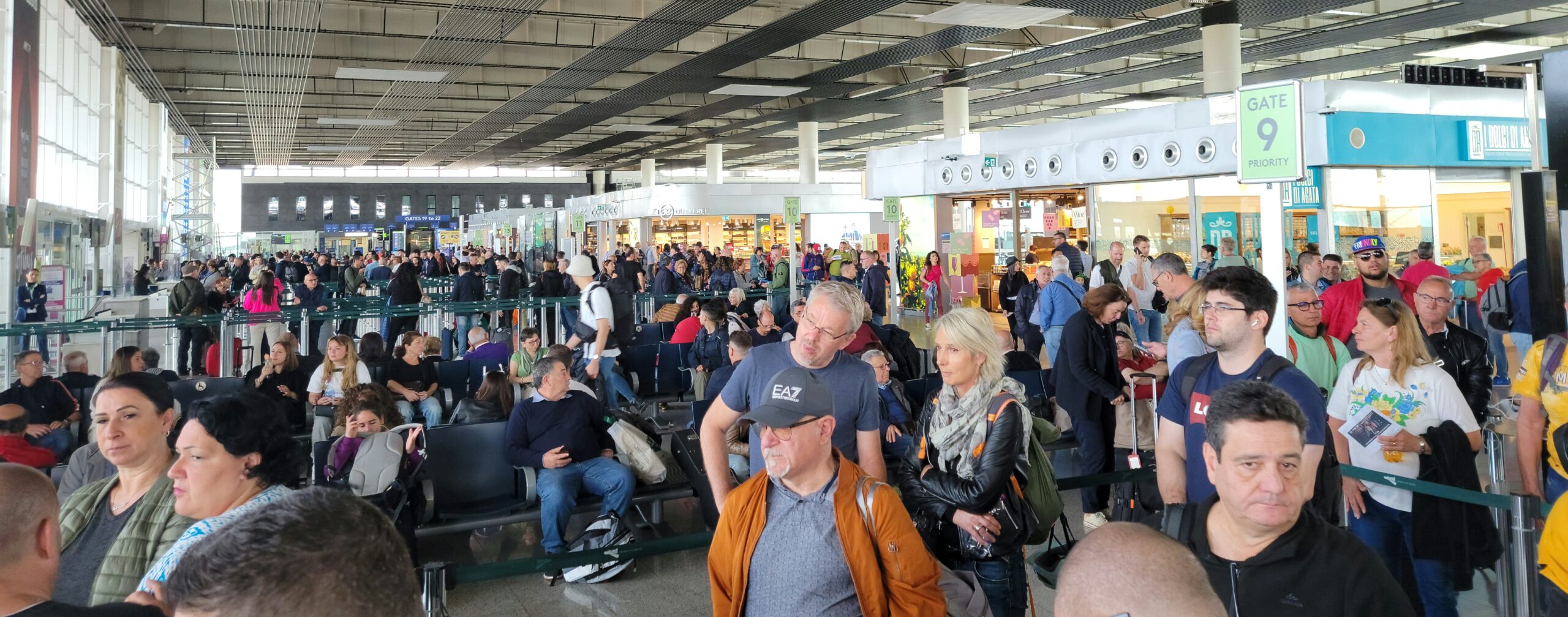
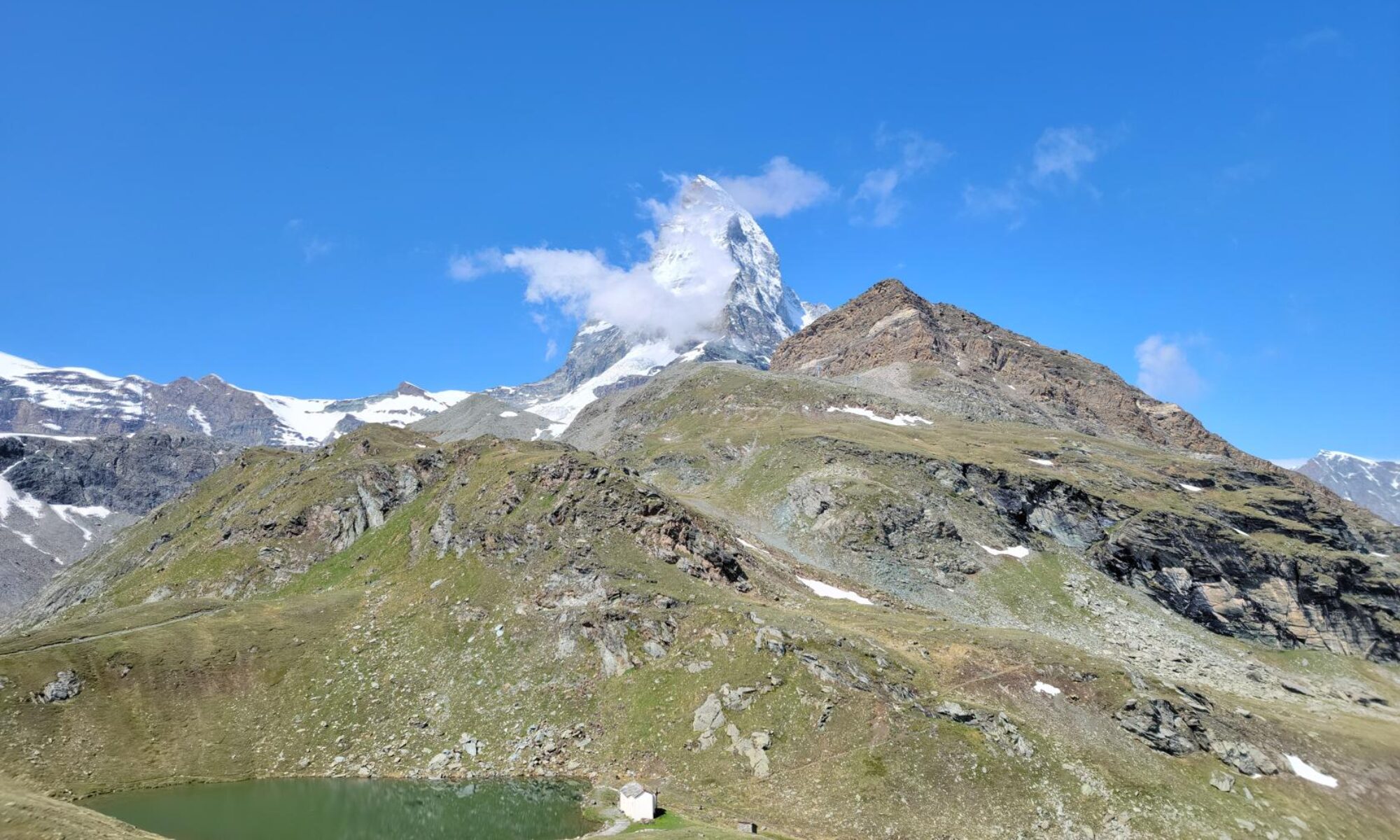
Containing a journal of our life, its journeys, experiences we've had, things we love to do and of course family…!
If you are traveling this summer, be prepared, it’s a zoo! This is the small airport of Catania, Sicily – crazy…

Continuing our journeys on the eastern coast of Sicily, we arrived at Catania. A port city and working town that believe it or not, is even grittier than Naples.
Existing in the shadow of a large, ever erupting volcano, would seem like a fool’s errand. But the people of Catania do it everyday and only give it a second thought. Luckily, the volcano has not had a major eruption in some time, and since it’s monitored continuously, most people try to ignore it.
The city has at least one good park near the city center that is easy to visit. The Villa Bellini and Park Maestranze is right off of Via Etnea and has some great views of the volcano and a very quiet place to visit.
The presence of Etna is felt everywhere, from the architecture, to the items some of the shops sell, to the very grit you grind under your feet as you walk. Even though as you walk the streets and cannot see it, it will rear its ugly snow-capped head as you round a corner, or ascend some lookout in the city.
Many of the ruins in and around Catania contain theaters and baths from the Greek and Roman periods.
A stone’s throw away from our hotel the amphitheater forces all the traffic to go around it. There is not much story behind the amphitheater other than in the fourth century the town’s people had started robbing it stones for building material. Later it was almost completely covered up by a building project in the eighteenth century. It was later rediscovered and preserved as part of an urban archeological site.
Very close to the Greek and Roman Theater are the Roman Baths. They appear to be part of a city walking audio tour, but since we did not visit the information center, we have no other details on the site.
Labeled the Roman Theater, it was actually established by the Greeks and later rebuilt as a Roman Theater. There is an entrance fee for this exhibit, which again seems to be repurposed for shows. Though there is ample space to take photographs to get a good idea of how it used to look.
There are numerous churches and other religious structures of note all throughout Catania. The most noteworthy one is the Cathedral of Catania.
A large unfinished artifice is the Church of San Nicolò l’Arena. It was started in the late 17th century and interrupted by the large earthquake of 1693. The dome and inside were later completed, but the facade remains unfinished sadly even to this day.
This church has a secret though, for small fee you may ascend its narrow spiral staircase to the roof for its impressive view of the city.
From this perch you can also get an amazing shot at Mount Etna.
Along the left side of the church of San Nicolò l’Arena is the Monastery of the Benedictines. Unfortunately,
it is only open for guided tours and they were completely booked up when we inquired with school groups and other tour groups. We were lucky however to get a glimpse of some of the grounds which is also used as part of the university, which holds lectures on philosophy and other classical topics.
This basilica has a Sicilian Baroque facade that was designed by Vaccarini in the early 18th century. It has a clock tower and a large piazza outside it to support its impressive entrance.
The interior is very large and has ten or twelve sub-chapels along its walls. There are three main altars, the two are the sides appear to be lit at all times, while the main alter, along with its wooden pulpit is probably only used to special occasions.
This hotel is situated above the main thoroughfare of Via Etnea (Etna) and just outside what would be perceived as the nice part of the city. It is most likely, the nice part of town has moved over time and now it finds itself a bit on the margins; but it is a great four-star hotel and the rooms are really great. The staff is very courteous and knowledgeable. Irons are not in the rooms but are available for those seeking to touch up their clothes after a hard travel.
We were booked into a luxury room and upgraded to the Estasi suite, it was almost as big as our entire apartment in Turin!
Like any large city, Catania has a variety of restaurants to choose from, including Asian and other cuisines. Since our stay was so short we stuck with the local favorites and something new as well.
This is a very good restaurant with excellent typical Sicilian food. It has a limited menu, but that’s what makes it so great. What ever is on the menu is delicious. It was so good in fact, we ate here both evenings.
A new kind of boutique restaurant, it has a select menu of typical dishes created with some style. The outside seating is under a very large tree where you can enjoy your food and the great weather. The staff is fairly energetic and responds quickly if you require any assistance or your bill. As with most establishments in Italy, you pay inside at the cashier.
To my knowledge there is no analog in the United States to the custom and festival similar to the one practiced in Noto, Sicily. Each year the town and local people celebrate the Infiorata, or festival of flowers. It is one of three towns known to have such a festival, which includes the towns of Spello and Genzano.
Noto is a world heritage UNESCO site and is well known for its cathedral and other archaeological wonders. Not only does the Noto Cathedral represent the epitome of Sicilian Baroque style, but it is the major landmark in the city. Over the years it suffered damage from repeated earthquakes and shoddy repairs, only to finally collapse in the 1990s after years of neglect. The church that stands before us today is almost a complete resurrection of the former cathedral, since only the facade and outside walls escaped destruction.
It was totally destroyed in 1693 by an enormous earthquake and devastated it and the surrounding towns and villages. More than half of the residents perished in the violent event. It was later reconstructed at its current location in what is now considered the Sicilian Baroque style. Below is a slideshow with other sites that we saw while visiting, mostly churches of course.
The entrance fee on-site is 3€/person, however we booked our’s through the website and were charge 3.50€/person, plus an additional .60€ for processing. So keep in mind, obtaining your ticket early may not always be the best or most cost effective.
The route of the flower festival is in the center of town and includes the entire street of Via Corrado Nicolaci. This year’s theme was Italian cinema.
After taking in the flowers, the festival continues down by the Porta Reale Ferdinando and the park Villa Communale off of Corso Victoria Emanuele. Here you can buy all sorts of fair type items, from home-made nutbars, granola bars, specialized candies and other assorted items and drinks.
We only ate lunch here, but the place we originally chose was closed on Tuesdays, so we had to adapt and chose another place, which was timely, because the weather was not cooperating again.
Situated on the main shopping thoroughfare in the middle of town is Cortes Ristorante. Here one may easily find a typical Italian dish to enjoy for lunch. I ordered an Insalate Mista and Spaghetti with garlic and oil, Patti ordered the Spaghetti with garlic and oil along with crushed pistachios. The food was very good and the prices were reasonable.
Syracuse, or Siracusa as you will find it readily marked throughout the island, is one of the first places of historic significance within Italy. It was inhabited in ancient times and finally settled by the Greeks in the early eight century BCE.
The original settlement of the Greeks was on the small island of Ortigia, which still contains several historical and archaeological artifacts from the Greek and Roman periods. See the Ortigia section below for more on that part of the commune and city.
Syracuse is divided into three main parts, Ortigia the island and original Greek settlement, Santa Lucia along the coast and the location of our hotel, and the Neapolis the location of the major Greek and Roman ruins .
If you are at this point wondering what ash and puppets have to do with Sicily, and in particular Syracuse, read further. Otherwise, just rest assured it has everything to do with being on this quaint and wonderful island.
Note: Purchase the Museum and Park Combination Ticket at 18€. If you purchase them separately, it will cost you an extra 8€. The combination ticket will get you into both, with money left over for a light lunch.
The Archaeological Museum is an impressive collection of ancient, Greek and Roman artifacts dating back to the seventh and eighth centuries.
The museum handles each time period in a sequential fashion, starting with the ancient period of the pre-historic animals and tectonic changes to the area, all the way to the arrival of the Greeks and other colonial powers.
More than one area within the south-eastern coast of Sicily is addressed, as well as other major areas to the north and in the center. In all, the museum provides an excellent historical picture of the island of Sicily.
The Archaeological Park, also known as the Neapolis Archaelogical Park of Syracuse, is situated about two and a half kilometers from the island of Ortigia. However, a brisk walk can get you there in about twenty or so minutes.
Tickets may be purchased at the gate, now across the newly blue painted intersection.
If you follow the signs, like we did, you will be taken to group ticket sales, which will still sell you tickets, but its out of the way and you will have to walk through a path of vendors before actually finding the ticket booth.
When you enter the Neapolis the first thing to visit is the Grotto, or the large quarry where they used to mine stone for building. This is a huge cutout in the surrounding rock face which is about fifty or so meters in height.
It appears to have had several cave-ins in the past, which probably occurred as they were mining the stone. There is evidence of the former inhabitants leaving large columns behind in an attempt to prevent additional cave-ins from occurring. Whether they were successful or not, it is not known, there are no information signs or other historical information provided at the site.
Built into the side of the hill, the Greek Theater was originally constructed in the fifth century BCE and later re-constructed several times, including by the Romans. Currently it has been further modified by the contemporary Syracusians for use as a theater again, building a scaffold like theater on top of the pre-existing Greek Theater, in order to have out-door performances and other events.
Behind the theater is a necropolis and grotto, both of which may be visited while visiting the structure.
The Roman Theater is found on the way out of the park complex and extends to the exit for some way.
Ortigia, also known as Ortygia or Citta Vecchia (old city), is an island within the city of Syracuse. It is connected to the mainland and the rest of Syracuse by two bridges, the Umbertino Bridge and the Bridge of Santa Lucia.
At the entrance of the ancient city is the Temple of Apollo. This is the first site anyone will see upon entering the city. Continuing around the temple visitors will automatically ascend the Corso Giacomo Matteotti, or the main street. This is the main shopping street, containing all contemporary brands and shops and will lead one to the Fountain of Diana.
From this traffic-circle; going to the left will take one to the Puppet museum and theater, and the eastern part of the island; going right will take one to the Piazza Duomo and the tourist shopping street, which will also take you to the Syracuse Cathedral.
This is an interesting little museum covering the history of a specific heritage of puppet making on the island of Ortigia. Therefore, the puppets are specifically built around tales and folklore of the people of Sicily.
The puppets range in size from small (approx. 20cm in height), all the way to life size. There are many examples of finished products and some of contemporary origin. One display also shows the progression of making a puppet, from the carving stage through final assembly. All very instructive.
I was originally hesitant to go the Puppet Theater. But after attending a show, I am glad I had. Not only does the host explain the tale in great detail in English, before it is performed. But the actually acting and enactment of the tale was so compelling, I was captivated, even though I had no idea what was being said at many points during the performance.
The theater space is very personal, with only enough room for about 50-60 people, and they will seat others if needed in the aisle (on the steps). Therefore, if you need to take any medically necessary precautions in cramped quarters, be prepared before you arrive.
The Maniace Castle sits at the tip of Ortigia and commands an open view of the Ionian Sea. It is a rather simple structure in function and betrays itself to its many uses down through the ages by its many apparent modifications, including the installation of the lighthouse.
It is however complete with a moat, or in this case, a large drained sunken area where you can wander and only guess what it used to be like back in the day.
In the center of Ortigia sits the Cathedral of Syracuse, a large and fairly simple structure as cathedrals go, having no real apse, but only central and left naves.
The inside however is impressive and elegant and worth a visit. The outside of the cathedral displays Doric columns of the original Temple of Athena, which stood on this site prior to the building of the edifice.
For the six nights we stayed in Syracuse, we stayed at the Musciara Resort. This boutique resort is located about a 15 minute walk from Ortigia Island and has its own beach. It is a three-star hotel, but it is expertly appointed and maintained. There are only about a dozen or so rooms, so book early if interested. It is a on the pricey side, so if you are able, use points.
Though we did not use the beach at them, since there was a severe upper level low causing rain for many days, we know a set of two lounge chairs and table will cost 110€/day for those wishing to enjoy the water or work on that tan.
The cuisine of Syracuse is of course based mainly on the sea, so people who love fish will definitely enjoy themselves. There are myriads of fish to choose from, as well as octopus, squid, cuttlefish and assorted shell fish.
We ate lunch here and thoroughly enjoyed ourselves. They have a nice garden where one can enjoy an relaxes lunch away from the hustle and bustle of Piazza Duomo.
The food is typical and simple for Sicilian cuisine. We picked basic items, along with the house wine and had a very nice lunch. The staff were attentive and had a very good grasp of English, so communicating in my broken Italian, although appreciated, was not totally necessary, our waiter spoke and understood Italian, English, French and German.
A gastronomic pleasure with an unpretentious interior is Ortigia’s In Tavola Ristorante.
Here, as with many other place, they have home-made pasta and spaghetti. However, we ordered fish, swordfish for me and mackerel for Patti. For dessert we had lemon pie and a cannolo, along with an coffee and an aperitif, the a Sicilian Amaro, for 77€ for two people.
Having been eating Italian and SIcilian food for too long, we tried RIstorante Cine and really like it. Though the ingredients are different from what we are used to in Turin and the States (though not unusual), the owner was more than happy to alter any dishes to our tastes. We only ate lunch here and for two, we were able to order an appetizer, primi (vegetable rice) and secondi (chicken or pork or vegetables in white sauce), along with a half carafe of red wine, water, coffee and sambuca for under 30€! It is hard to beat that in a tourist area.
We ate lunch here on Sunday, the 21st of May, 2023, after visiting the Archaeological Park and when unbeknownst to us Mount Etna was erupting.
After we finished and began walking back to the hotel, we noticed dust getting in our eyes. At the time we had no idea why and surmised that the recent bad storm had brought in dust from Africa, which can occasionally happen. When we read the next day that the Catania Airport had closed due to ash if finally dawned on us that it had been the ash from the volcano all those miles away that was the cause.
If you are looking for gelati in Sicily, do not buy the brightly colored ones, usually they are made of inferior ingredients. Instead, look for the Artiginale label. Though you will pay more for a cone of cup of this, it will be far more worth your while in taste later.
Another good Gelateria, providing excellent artisanal gelati. I was particularly fond of their Amerano and Pistachio flavors.
Finding very good gelati anywhere in Italy is not a difficult task, here is no exception. It has great artiginale (artisanal) flavors, I ordered the Ortigia and Note Di Sicilia, and Patti ordered the Note Di Sicilia, Mandarin Orange and Dark Chocolate with a hint of orange.
We have traveled a lot throughout Europe and especially Italy and occasionally you will get a rainy or snowy day. But nothing prepared us for our arrival in Cefalù, or as we write it in english, Cefalu; a small touristy town situated on the north side of the island of Sicily.
We arrived by Trenitalia’s Pop train from Palermo, which runs approximately every hour and costs around 6.50€/person. These are normally local tourism trains in the major areas and can be called Pop, Jazz, or almost anything. They provide reasonably priced and fast transportation to the coastal tourism spots. If you need to travel a longer distance, you will most likely have to use the normal Trenitalia or Intercity service.
Similar to other touristy spots in the US and other parts of the world, Cefalu is definitely administered and managed for the traveler. Though quiet during these months, I can imagine it can get a bit noisy during the summer months with its extensive beach and boardwalk beckoning travelers on. With the addition of all the shops and artisans in town, you have the perfect recipe for the tourist trap. So, if you are only interested in the historic aspects of the town and area, it probably behooves you to travel earlier or later in the year, in order to avoid its busy potential. Otherwise, if you are a sun lover, this could be a very good destination for you.
Other than that, we happened to arrive when Sicily was getting one of its worst storm system in twenty years. Not only did it rain incessantly, the wind and the temperatures made for a quite challenging time. If there wasn’t water, water, everywhere, there was always the threat of rain, so you always had to pack an umbrella. We got wet so often, we started debating whether we should go out at all. We were glad we did, otherwise there would have been no way to see everything that we did in such a compressed time.
The Mount of Pity was first funded in the early 1700s by Don Vincenzo Costa. The institution became very important to the economy of the city, but after World War II fell into decline. It has elegantly framed windows and a molded lintel and is an example of the advanced baroque architecture in Cefalu.
Not far from Il Duomo and in Piazza Garibaldi, almost next to Ristorante Porta Terra is the Torre Orologio, or the clock tower. Like most other cities, probably the go to place at one time to set your own timepiece to, but now, though it still functions, appears to be in dire need of some repairs. While we were eating at Porta Terra, we noticed the bells do not function perfectly, even though if you paid attention, it appeared to tell the correct time within a few minutes of the actual, even though the ringing was quite muted.
This little historic bit, easily missed by the unaware tourist ambling along the via Vittorio Emanuele, is an old laundry.
Made out of stone and fountains, the town’s people in the old days used to come here to do their laundry. It is still in working order, though modern day appliances make its use today superfluous.
The Cathedral of Syracuse sits on high ground directly under the La Rocca, or The Rock. It has a large piazza and spacious interior and can be seen from some distance. While we were here, it was under renovation inside, so we were unable to see it in all its glory.
You enter the hike to the caste via the Rocca di Cefalu. It starts out with finely paved stairs and steps, that one would typically find in any Italian town with hills in it.
The entrance fee is 5€/person and the experience will definitely introduce one to the true meaning of Italian bureaucracy. Not only is there a self-service machine, but someone there that actually asks you what you want, takes your money, purchases the ticket for you, then hands it to someone else in the kiosk who is there to tabulate the number in a book. This number is again used when you leave, so do not throw your ticket out. Once your ticket is returned, another person is waiting to take it from you and helps you scan it in the automated turnstile. All in today’s times totally unnecessary. There is obviously either some abstruse Italian or municipal law that probably requires them to do so.
After the turnstile, the hike starts immediately to climb. There are hairpins all along the way up until you enter the first set of walls and gates, which were the first line of defense. This was a perfect point in which to take a few photographs and enjoy the view of Cefalu from above.
The hike then brings you to a fork in the road with a sign, archeological ruins left, castle right, we chose the right route, figuring we wanted to see it first. It then continues and enters a steep area of tree and grass along sheer walls of stone, home to a large number of goats. If you pay attention, you can hear their calls and see them climbing the stone walls as if to mock you.
After what seems like another half an hour of switching back and forth along the trail you enter the area of the castle. Here are the remnants of the once grand Cefalu Castle, Perched high above the town, it had a commanding view of the countryside and in its time, must have been unassailable. From here one can take amazing photographs of the town below, the sea and the beautiful countryside below.
On the way down we bore right in the direction of the archeological site. The path was somewhat muddier and steeper then the other path we ascended upon. However, we descended quickly and enjoyed visiting the Temple of Demeter and an old cistern that is onsite. There is also a cafe here, were you can purchase something small to eat or drink. From here the descent is rapid and soon enough you will be handing the ticket back to the office so they can record your departure, or whatever useful information they derive from it.
One of the many pleasures of the Italian countryside and its parks, are the flowers. Italy goes out of its way not to poison things, so there are numerous flowers and other blossoming things around, where bees and other pollinators can feed. Here is a short slideshow with some examples on this hike.
Our hotel was situated right across the street from the boardwalk and the sea. The views were very nice and we found it especially convenient, instead of being directly in town, where the streets are more confining and more difficult to move around in. The rooms here are fairly spacious and have most of the amenities that Americans are used, with the exception of an ironing board and a few other things. All and all, the staff is very friendly and welcoming and the downstairs cafe has excellent coffee and also a gelato bar, which we frequented more than once.
We ate dinner here the first night in Cefalu. We chose this restaurant due to the threat of rain and because it was right up the street and very close. Unfortunately at the time, we didn’t realize that being in the vicinity would help much staying dry.
The food here is typical Italian pizzeria, very good and very reasonable prices. They have pizza, calzone, spaghetti and pasta dishes, and a wood fired brick oven to cook it all in.
We actually ate here twice, once for lunch and once for dinner.
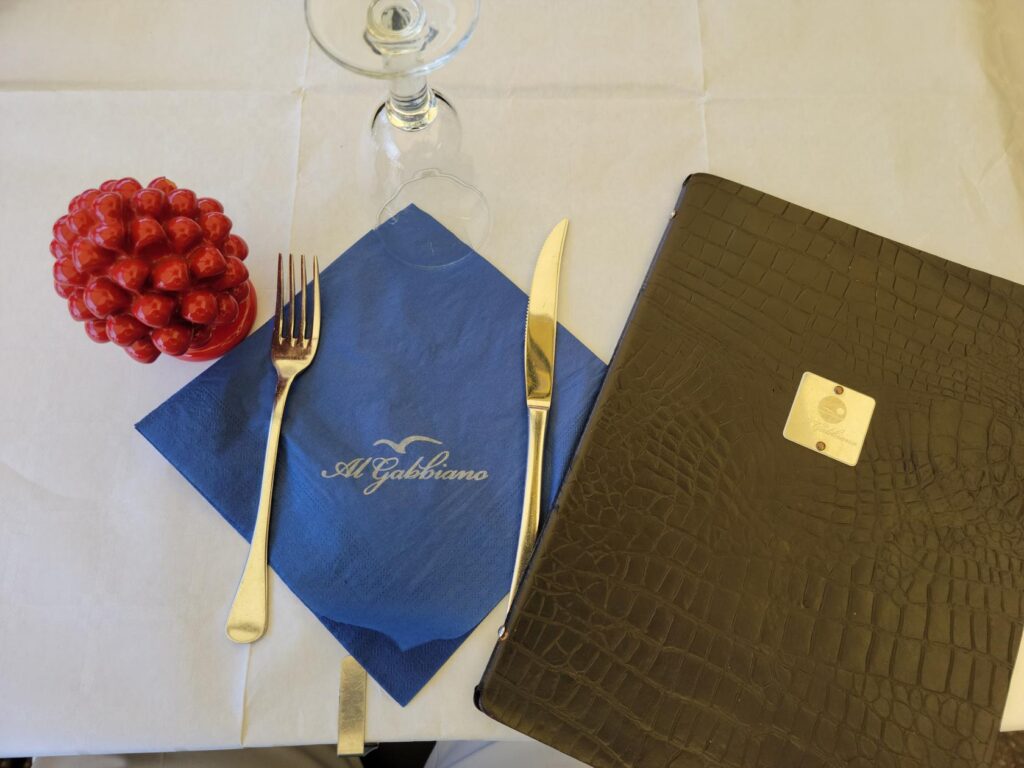
For lunch we ate outside, since the weather was trying to improve and it was rather nice out. I ordered the Zuppa di Verdure and the Spaghetti al Pomodoro and Patti had a mixed salad.
For dinner we ate inside, since the evenings in May can be rather cool, especially with the breeze from the sea blowing inland. I ordered the the mixed salad and the Spaghetti Bolognese, Patti order the Spaghetti al Pomodoro I had the day before. Both were delicious and with wine and water came to a reasonable 35€.
This is a delightful restaurant for lunch and is located within the town on via Gioeni. It has a full manu and will please seafood and land lovers alike.
I had the Zuppa di Verdura con Legumi and the Lasagna, while Patti finally found here Aranchini on the menu and ordered a sampler plate of that. Both were delicious. With food, a hald liter of wine, water and coffee, it came to a reasonable 37€ for two.
A fine restaurant located in the Piazza Garibaldi in the upper part of town. We booked our reservations using The Fork and got a free hors d’oeuvres of Cherry Tomato, Mozzarella and Pistachio Cream in a small baked bread cup.
I ordered a glass of a fine red Sicilian wine called Nero d’Altura. Patti had the breaded tuna with Mango and avocado sauce, and I had the baked cod with a reduction of pinoli nuts, raisins and kalamata olives over mashed potatoes, both of which were delicious. The dinner was a bit on the high side at 71€ for both of us, but the food was worth every cent.
Situated on the north coast of the autonomous region of Sicily is Palermo, both the capital of the province and of the region itself. It is an ancient city which has been ruled over its long history by many different powers. It was once a nexus for essential trade routes in the Mediterranean Sea.
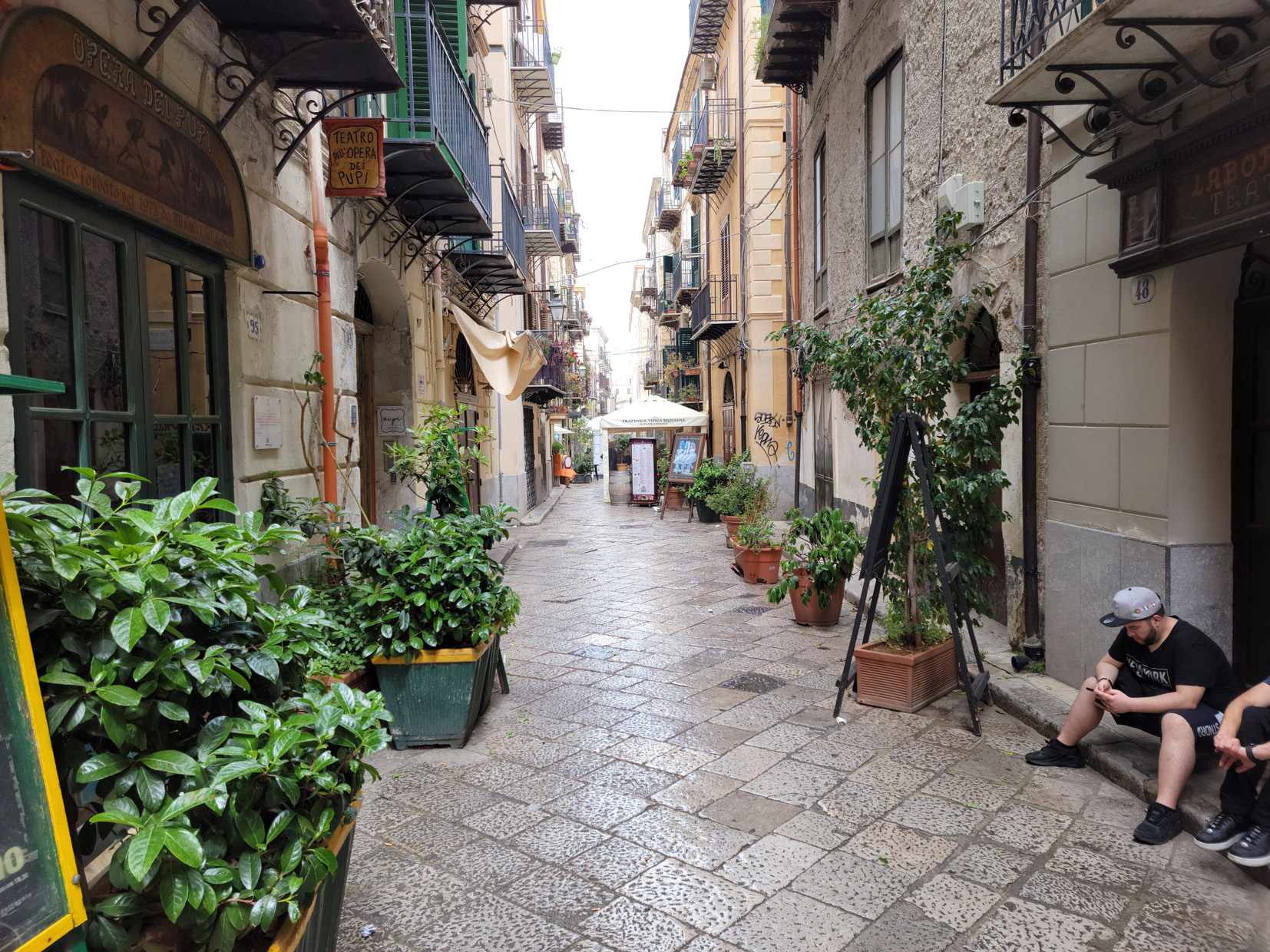
We arrived at the Palermo Airport, which is actually not in Palermo, but in Punta Raisi. There are many options one can take in order to get to Palermo, ranging from the train at 6.50€/person, all the way up to private shuttle service starting at 50€/person. Being from a family of railroad workers, I prefer to take a train when possible. Not only is a far cheaper, but in Italy they almost always run on time.
One last thing, unfortunately our Tickets For Two were electronic, so it does not make sense to show, nor take a photograph of them. Let us just say, we had two tickets on a Ryanair flight from Turin to Palermo at a very reasonable rate.
In our contemporary time, I would say the city of Palermo is struggling between its ancient roots, as with many other parts of Italy, and its desire to be modern. This is reflected in many ways as you walk through its narrow alleyways and marbled streets. Some of which are well worn with centuries of wear.
Palermo sports amazing architecture and a church around almost every corner. The Gesu Church and the Palermo Cathedral, may be of particular interest.
On the other cultural side of things, there is the Massimo Theater. An impressive building that is named after the piazza in which it resides.
A few other interesting sites include the Porta Nuovo and several parks, one of which has a magnificent example of an Australian Banyan tree. However, there are many site to enjoy while strolling the city streets, sometimes it pays just to get lost, even if your favorite map is uncooperative.
Situated in the Piazza Massimo, almost at the start of the pedestrian zone on via Maqueda, was our unassuming hotel, Hotel Massimo Plaza. The staff was very helpful and our breakfast was served in our room, which we often find very helpful, especially when the weather is not cooperating, like it wasn’t on this trip.
In our short stay in Palermo, we found the following restaurants noteworthy. The cuisine of Palermo is typical for a southern Italian port city, most restaurants having plenty of fish and seafood on the menu. However, there are plenty of pizza places and small cafes as well, where one can purchase smaller items for takeout or to eat as they walk.
This restaurant was just around the corner of our hotel and offers authentic and excellent southern Italian pizza. You may see the term pizze in your travels, but do not be deterred, that is just the plural form in Italian for more than one pizza, it’s the same thing.
We ordered a caprese and a pizza each, I had a glass of wine and we ordered a bottle of water and the bill came to 25€ with 4€ coperto.
After our short stay here, it was on to the real start of our trip, Cefalu. Although there is plenty more to see and do in Palermo, our trip itinerary did not allow us any more time here. So using our senior discount cards, we purchased two more Trenitalia tickets and we were on our way.
In the event we do return, we plan to stay here longer and perhaps see more of the western portion of the island as well. Aside from the rain, we still had a pretty good time here and enjoyed the city of Palermo for its sites, cuisine and true grit.
To return to Turin this year, we chose to depart from the Raleigh-Durham area using Delta Airline’s RDU (Raleigh Durham International airport) to CDG (Paris Charles de Gaulle airport, located in Roissy-en-France) flight, as we had done occasionally before Covid-19 hit the world and Delta subsequently cancelled the service. Now that Covid-19 is more or less forgotten, let’s just say travel is back in full swing and with it – other changes, delays and of course cancellations. So if you are planning any international travel this year to Europe or anywhere for that matter – grit your teeth, hold onto to your hats and try to be flexible.
One of the major disadvantages of flying out of a minor or small international hub like RDU, is that, if there is any type of problem, any delay longer than an hour or so, especially due to a mechanical issue, can and often do become cancellations. This happened to us early last week after we boarded our plane. About ten minutes after being on board, Delta discovered what they thought was a refrigerant condensation leak, which in the end turned out to be a fuel leak. Really?! The plane had landed hours before and was being turned around for its return trip and they discovered this issue only moments before we were planned to take off. My wife and I could not believe what we were hearing. In fact, the flight crew were also so surprised, the pilot came out to address us personally and answered any questions.
Well I guess it’s better they discovered the issue before we left, then while we were over the Atlantic. It just makes one wonder if we should be worrying more about the inspection schedules of these aircraft, regardless of their safety records. In any event, our delay of one hour turned into three hours, then five and then they finally cancelled to flight within an hour of the first announcement. The primary reasons; no spare flight crews available locally and they could not fix the plane in Raleigh.
Luckily, we had already left the gate and decided to get our luggage pulled from the plane, which is a long story in and of itself (we ended up only getting one and had to come back the next day for the other one). Even after getting the jump on everyone else, we still left the airport around midnight to return our son’s apartment and rescheduled our flight out a week (Delta was not pleased with us, but it was their fault and they still paid with extra points, etc.).
Six days later we arrived in Paris without incident and took a taxi into the city to our hotel. Since we are IHG members we booked and stayed at the Holiday Inn – Gare de Lyon. Rated a four star hotel, it is more likely a three star hotel posing as a four star. We have stayed at many privately run three star hotels that were better run and better appointed. However, it was clean, the rooms are fairly spacious and there is easy access to the metro and plenty of restaurants nearby. Moreover, it is away from the most tourist visited areas of the city. Given all this, I still would NOT recommend it. There have to be better hotels and choices available, if one has the time to look. Plus it is missing some important amenities for an American hotel, if you look close enough to notice.
Though we took a taxi from and to the airport, I would recommend the RER instead. Traffic in Paris is a nightmare. Though the taxi is not in itself expensive, the travel time will be at least an hour each way. Almost all the roads coming into Paris on many phone map apps will be red or worse yet, dark red, and for twenty or so minutes of our ride we were motionless.
Our original plans were to spend a week in Paris, but with our cancellation, those plans had to be altered and we only got to spend two days. However, with all of uproar over raising the retirement age here and the never ending threats of strikes, train and venue cancellations, and all of the protesting; it was probably a good idea to cut this trip short and just plan it for another time. In any event, since I have already been to Paris a few times, I was able to show my wife a few of the most notable sightseeing locations, while occasionally enjoying the food.
The city is eminently walk-able and has an excellent metro. The metro can take you almost anywhere and everywhere you want to go, including back to the airport via the RER. However, in order not to miss anything, you will find walking the best option. We found walking out and taking the metro in between to be the best combination.
This large boulevard is a common venue for the final day of the Tour de France. With its rectangular trimmed trees along each side and four lanes of traffic, it connects two of the city’s main points of interest – the Arc de Triomphe and the Place de la Concorde.
Unfortunately we were unable to see the tower at night due to scheduling constraints, and even then, only at a distance. Even from across the Seine it is still impressive.
Yet another reason to come back at a later time, the poor Notre Dame, victim of a senseless fire, being reconstructed. Being complacent about anything, will always get you in the end. Yet sometimes to get politicians to act on anything requires a tragedy.
Due to our shortened stay, we were only able to visit one restaurant of note and it wasn’t even French. However, we were able to stop at several small cafes for breakfast and lunch. All were reasonable priced and the food was very good.
A very small Italian restaurant a block away from our hotel on the Rue Parrot. It has very little room inside or out, so get there early.

The food is very good and ostensibly traditional Sardinian. Italians may find it odd that they have pasta dishes with meatballs, instead of separately. Not a show stopper for me, their sauce was very good and the pasta was cooked to perfection.
We really enjoyed Prague and because of the Vtlava River running through it, it really reminded us of Turin, though not as laid back.

Not only are there plenty of things to see and do, the city has many restaurants, more than one would think. One can find anything to eat, from Vietnames and Chinese food to all varieties of European cuisine.
The city also has a lot of parks in it, where one can go and enjoy a quiet walk, while admiring some of the monuments and art work that abound in this quiant little eastern European city. We leave you with a parting slide show and a few more restaurant reviews.
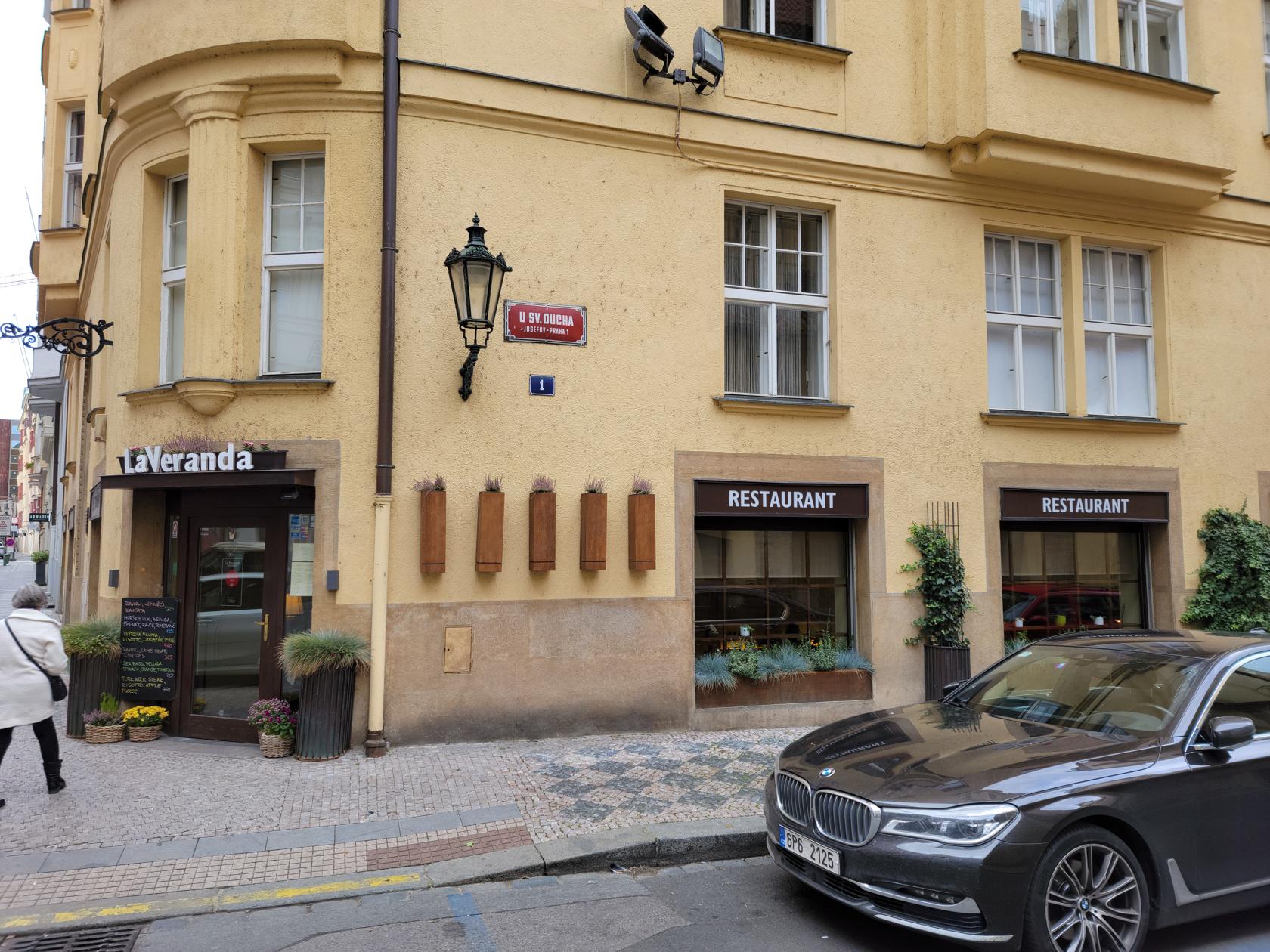
For our final day together, the four of us were lucky to stumble upon La Veranda Ristorante, a high end Michelin starred Italian restaurant with excellent food and wine. We spent a few maverlous hours enjoying lunch here, and if you have the chance, you should too!
The Black Elephant Restaurant
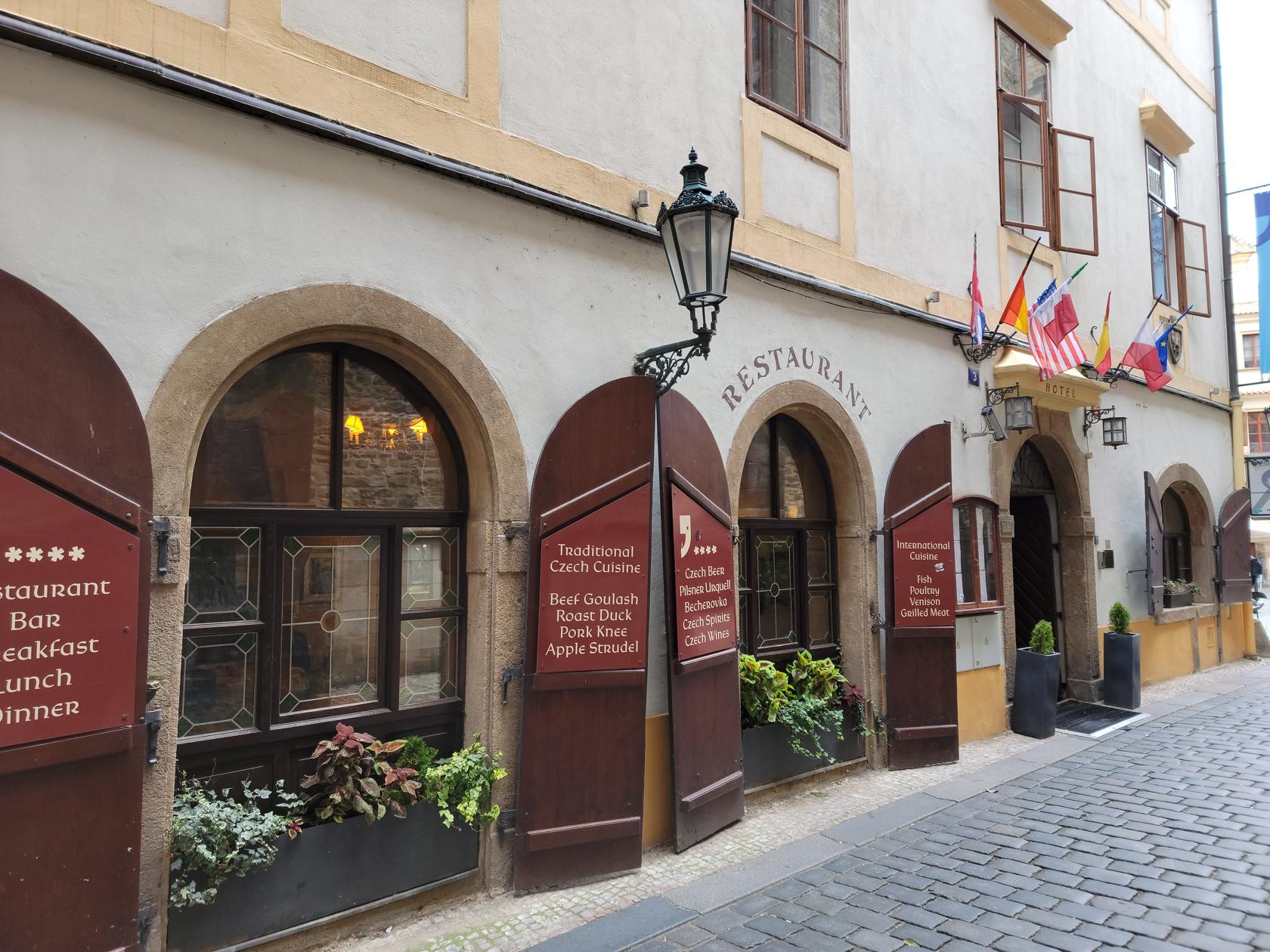
A truely traditional Czech restaurant, offering all of the local favorites. We expressely stopped in because they advertized and offered Roasted Pig Knuckle, or as the Bavarians would say – Schweinshaxn, which Patti definitely wanted to have before we left.
Above the city lies Petrin Hill. A walk of a little over a kilometer and about three hundred steps (if you happen to go that way), or you can take the funicular (which we found to be very crowded on the Sunday), so we walked.
The nice thing about walking, aside from someone you don’t know breathing on you in a confined space, is you get to see things along the way the others in the funicular won’t. Plus, if the weather is nice, it’s actually quite a nice way to spend a Sunday morning.
After Petrin Hill, we continued our walk along the river a bit, before going across the Legion Bridge. Here we watched the river boats enter the river lock mechanism, in order to continue their journeys up the river.
If you are looking for good food while dining in a very off-beat interior, look no further than Luka Lu’s. Located on Újezd street in Mala Strana, it is an excellent place for lunch.
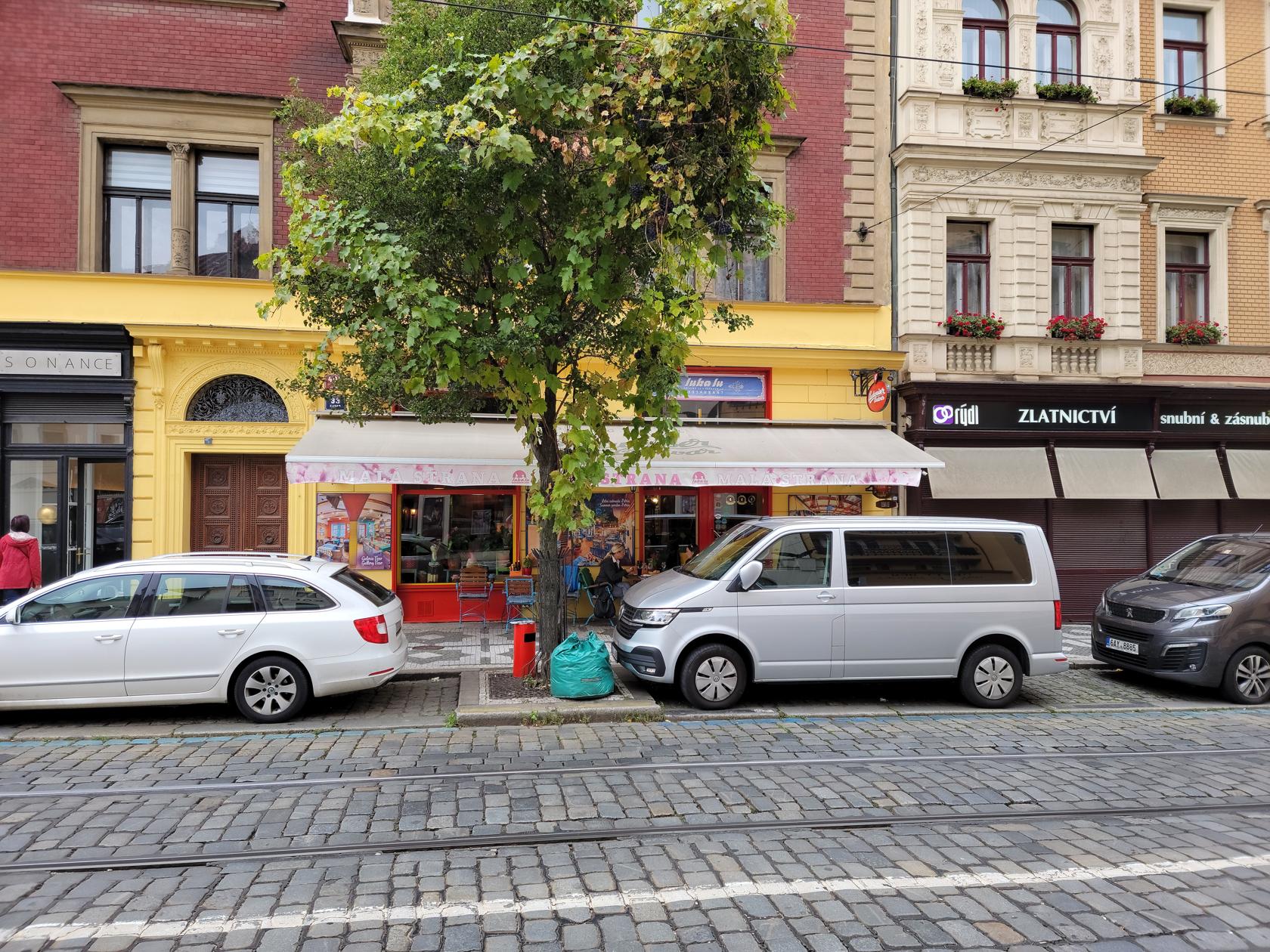
After our journey through the park and Petrin Hill, the four of us stopped for lunch. The food at Luka Lu’s was very good, service was great and the off-beat interior somewhat of a treat. If you are looking for something different, this might be the place for you. The prices were very reasonable too!
There are a few places in Prague that still have the medieval charm. One is a museum, the other is a restaurant. But if one is paying attention as they walk around, they will find little medieval curiosities hidden away. It only requires a bit of exploring to find them.
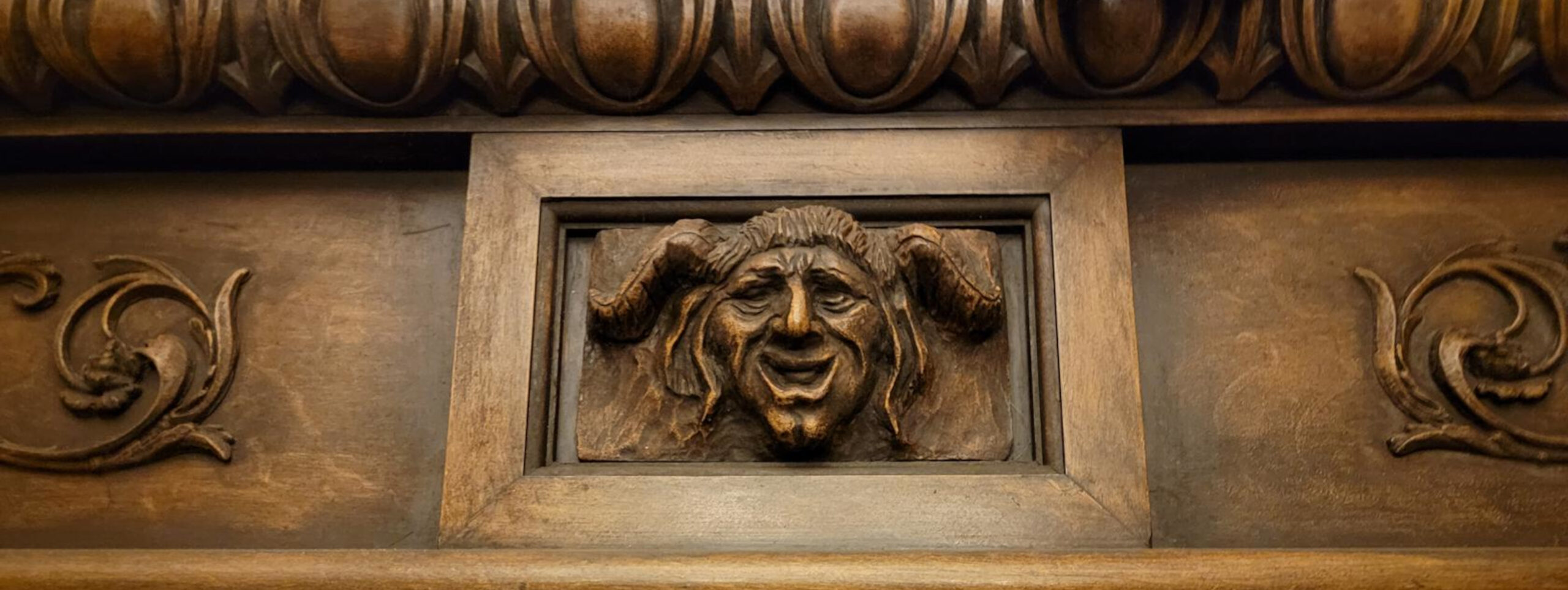
The most remarkable thing about the Old Town Square is its small size. It is surprising that such are large medieval city would have such a small square.
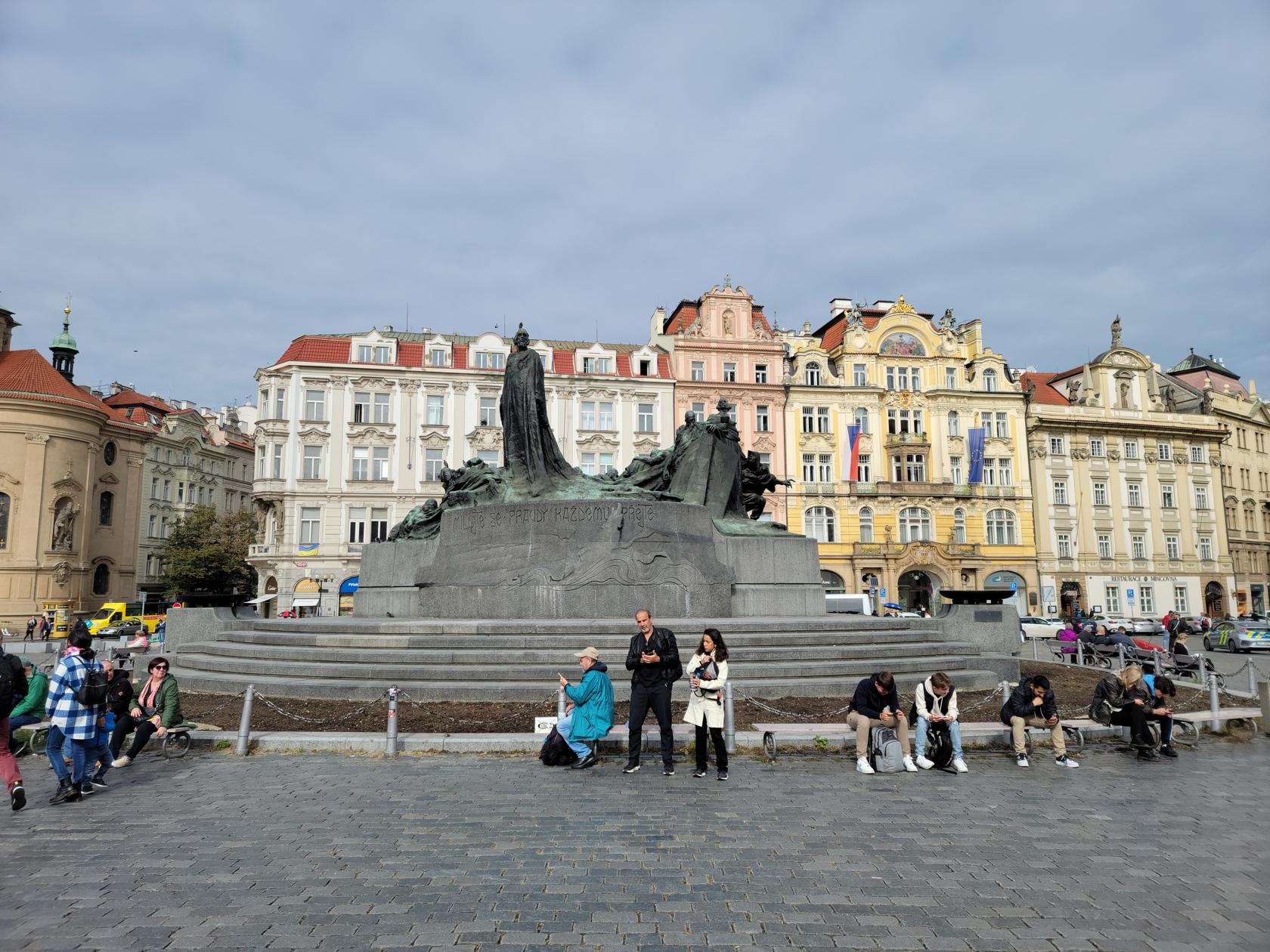
It does however have several remarkable points of interest and beautiful building contained or encircling it.
One of the main attractions in Prague is the Astronomical Clock. Aside from its obvious technical fascinations and color, it of course does not move a lot. That does not prevent many from craning their necks staring at it for more than an hour, hoping in vain for the clock to do something. However, the clock being based on a twenty-four hour daytime standard does move, but ever so slowly.
This museum offers guided tours through a historical alchemist’s shop, containing all of the accoutrements of the trade.
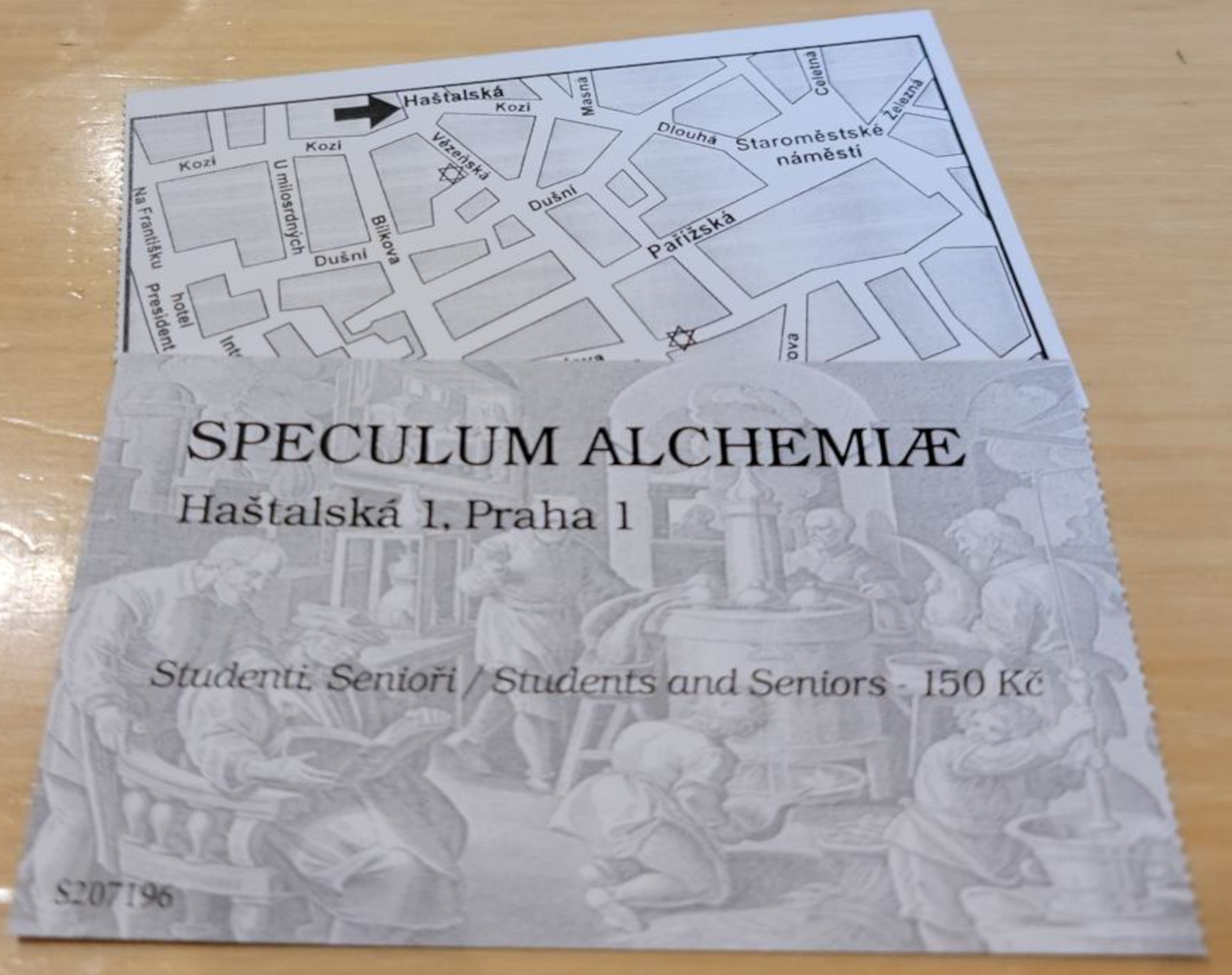
There are flasks, alembics, beakers and glass containers of all shapes and sizes littered throughout the shop.
The tour begins the shop and quickly advances through a door and small hallway to the alchemist’s study.
After a twenty minute talk on the herbs and other potions of the alchemist’s trade, as well as a short discussion on books, the tour commenced through a secret opening in the bookcase.
A creepy spiral staircase takes you downstairs into a dungeon like area full of workshops, each for a specific purpose.
If it was not mentioned before it will be now. If you are interested in any particular restaurants for dinner, make sure you book reservations beforehand. Most of the good ones book up quickly, some times days in advance, so make the call or send the request as soon as possible to get your table.
There are many fine restaurants in Prague and from what I can tell, they have all earned their stars. However, that’s not to say you will go hungry, if you do not make the proper arrangements. There are still numerous restaurants around of all types that might have an empty table, you just may have to do some walking.
There are also street food options, for both lunch and dinner. So, if you are not particular about sitting down, you can consider them as a viable option. As a last resort there are always fast food corporate options, but again, go local if at all possible and enjoy the native cuisine.
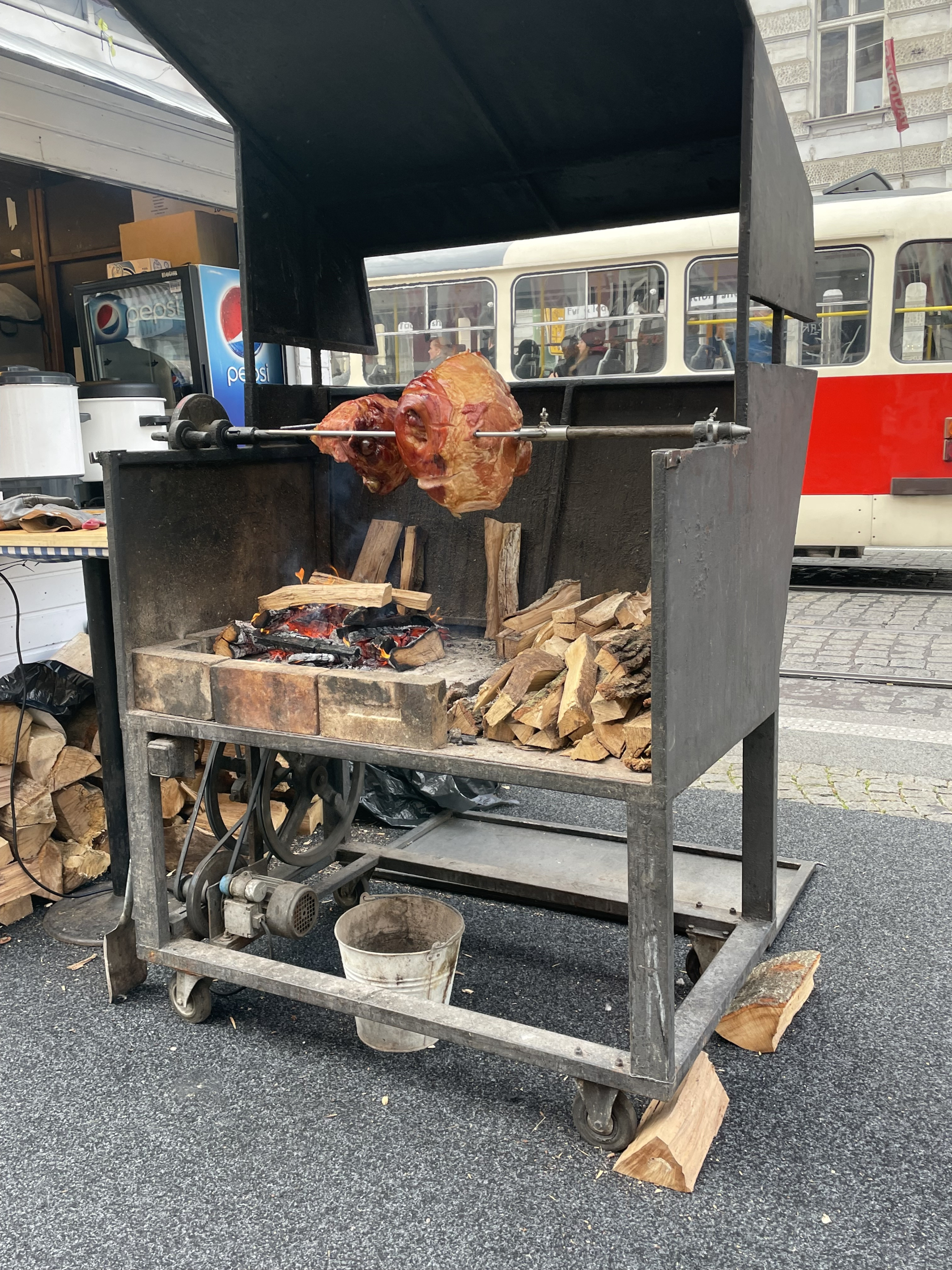
The first impression from outside is the establishment looks a bit odd, with a figure of a man outstretched from the basement. Once our interests were peaked, we had to investigate further and finally made reservations for the following day when the remainder of our party could join.
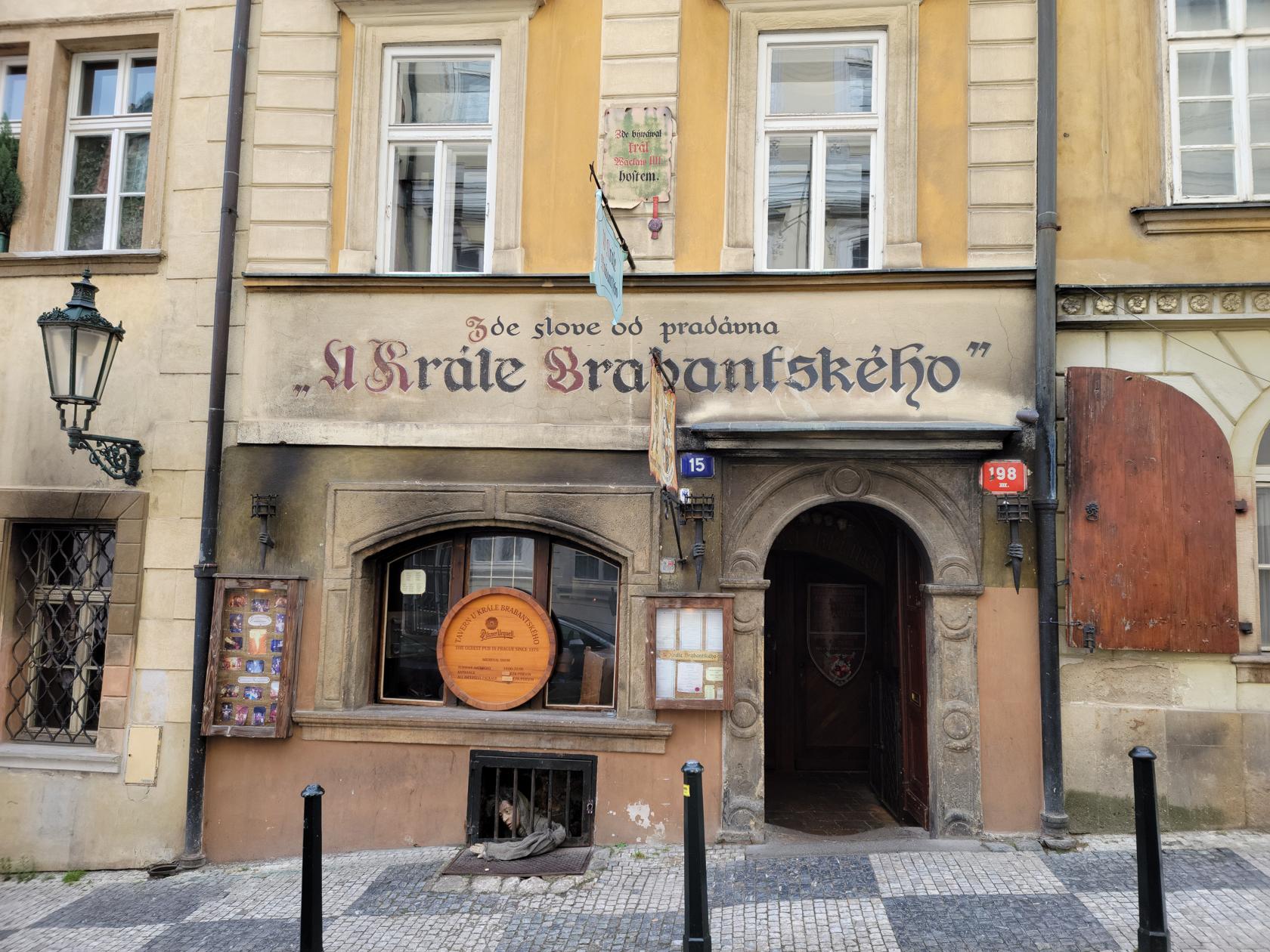
I have never been in a more dark or gloomy restaurant as this one, lending it a bit of medieval charm. Lit, more or less, only by candle light, it’s no wonder humanity made it out of the Dark Ages.
Participants should be aware, certain meals do not come with utensils and all of the beers come with a customary bang on the table. Some have been known to break their glasses, which is strangely allowed. The meals are, shall we say, good but very basic – they won’t be earning any Michelin Stars for their cuisine.
Also known in Czech as Petrské náměstí, is situated on Petrská, just behind our hotel. We picked another Italian restaurant since they are pretty wide spread throughout the city and the actual Czech cuisine is a bit limited.